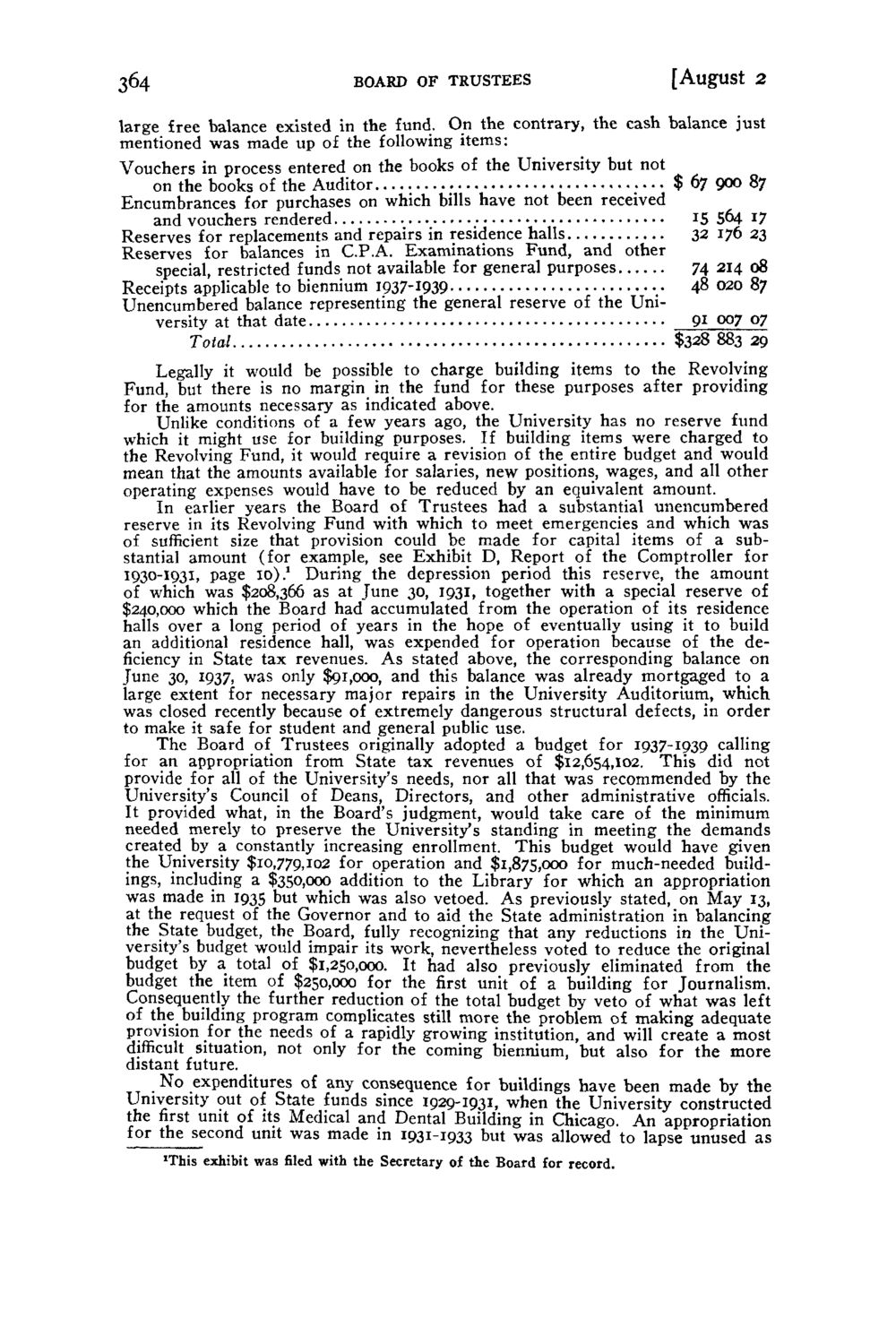| |
| |
Caption: Board of Trustees Minutes - 1938
This is a reduced-resolution page image for fast online browsing.

EXTRACTED TEXT FROM PAGE:
364 BOARD OF TRUSTEES [August 2 large free balance existed in the fund. On the contrary, the cash balance just mentioned was made up of the following items: Vouchers in process entered on the books of the University but not on the books of the Auditor $ 67 900 87 Encumbrances for purchases on which bills have not been received T and vouchers rendered 5 564 J 7 Reserves for replacements and repairs in residence halls 32 176 23 Reserves for balances in C.P.A. Examinations Fund, and other special, restricted funds not available for general purposes 74 214 08 Receipts applicable to biennium I937-T939 •.• 48 020 87 Unencumbered balance representing the general reserve of the University at that date 91 007 07 Total $328 883 29 Legally it would be possible to charge building items to the Revolving Fund, but there is no margin in the fund for these purposes after providing for the amounts necessary as indicated above. Unlike conditions of a few years ago, the University has no reserve fund which it might use for building purposes. If building items were charged to the Revolving Fund, it would require a revision of the entire budget and would mean that the amounts available for salaries, new positions, wages, and all other operating expenses would have to be reduced by an equivalent amount. In earlier years the Board of Trustees had a substantial unencumbered reserve in its Revolving Fund with which to meet emergencies and which was of sufficient size that provision could be made for capital items of a substantial amount (for example, see Exhibit D, Report of the Comptroller for 1930-1931, page I D ) . 1 During the depression period this reserve, the amount of which was $208,366 as at June 30, 1931, together with a special reserve of $240,000 which the Board had accumulated from the operation of its residence halls over a long period of years in the hope of eventually using it to build an additional residence hall, was expended for operation because of the deficiency in State tax revenues. As stated above, the corresponding balance on June 30, 1937, was only $91,000, and this balance was already mortgaged to a large extent for necessary major repairs in the University Auditorium, which was closed recently because of extremely dangerous structural defects, in order to make it safe for student and general public use. The Board of Trustees originally adopted a budget for 1937-1939 calling for an appropriation from State t a x revenues of $12,654,102. T h i s did not provide for all of the University's needs, nor all that was recommended by the University's Council of Deans, Directors, and other administrative officials. It provided what, in the Board's judgment, would take care of the minimum needed merely to preserve the University's standing in meeting the demands created by a constantly increasing enrollment. This budget would have given the University $10,779,102 for operation and $1,875,000 for much-needed buildings, including a $350,000 addition to the Library for which an appropriation was made in 1935 but which was also vetoed. As previously stated, on May 13, at the request of the Governor and to aid the State administration in balancing the State budget, the Board, fully recognizing that any reductions in the University's budget would impair its work, nevertheless voted to reduce the original budget by a total of $1,250,000. It had also previously eliminated from the budget the item of $250,000 for the first unit of a building for Journalism. Consequently the further reduction of the total budget by veto of what was left of the building program complicates still more the problem of making adequate provision for the needs of a rapidly growing institution, and will create a most difficult situation, not only for the coming biennium, but also for t h e more distant future. N o expenditures of any consequence for buildings have been made by the University out of State funds since 1929-1931, when the University constructed the first unit of its Medical and Dental Building in Chicago. An appropriation for the second unit was made in 1931-1933 but was allowed to lapse unused as 'This exhibit was filed with the Secretary of the Board for record.
| |